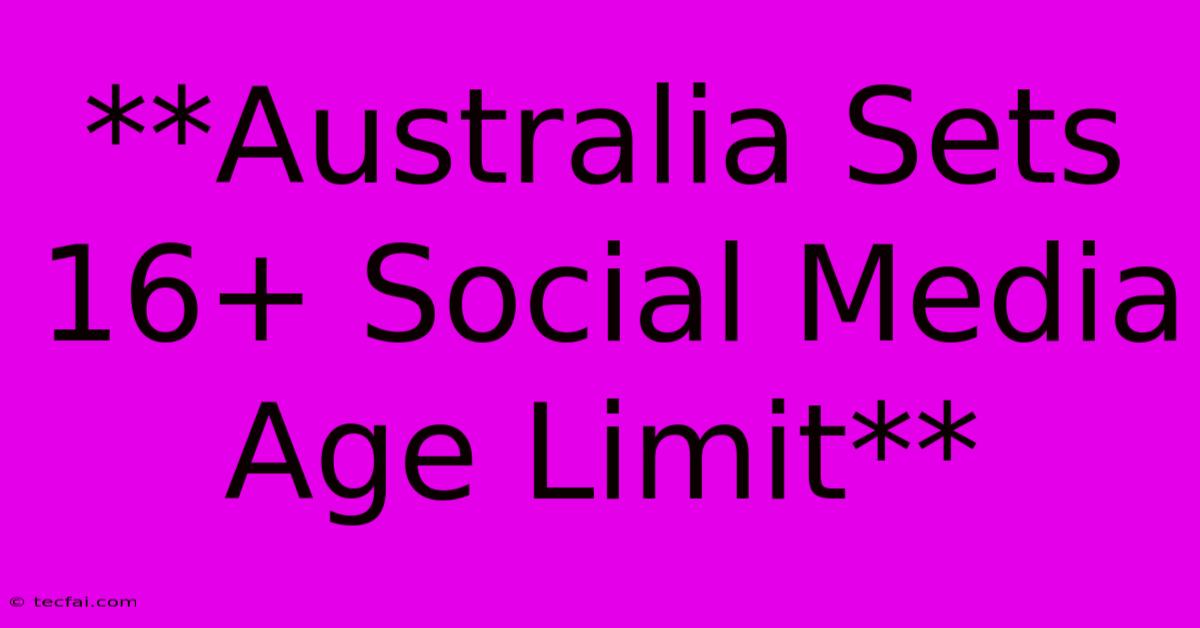**Australia Sets 16+ Social Media Age Limit**

Discover more detailed and exciting information on our website. Click the link below to start your adventure: Visit Best Website tecfai.com. Don't miss out!
Table of Contents
Australia Takes a Stand: 16+ Social Media Age Limit Aims to Protect Young Minds
Australia is making waves in the digital world with a groundbreaking decision: a new law mandating a 16+ age limit for social media platforms. This move, designed to safeguard young people from the potential harms of online platforms, is raising important questions about balancing individual rights with protecting children in the digital age.
The Rationale Behind the 16+ Age Limit
The Australian government cites numerous concerns driving this legislation, including:
- Mental health: The impact of social media on mental health, particularly among adolescents, has become a growing concern. Studies have linked excessive social media use with increased anxiety, depression, and body image issues.
- Cyberbullying: Social media platforms can be fertile ground for cyberbullying, leading to emotional distress, social isolation, and even self-harm.
- Privacy and data security: Young users may not fully understand the implications of sharing personal information online, putting them at risk for data breaches and privacy violations.
- Exposure to inappropriate content: While platforms strive to filter out harmful content, children may still encounter graphic or disturbing material that can be detrimental to their development.
How the 16+ Age Limit Will Work
The new law will require social media companies to verify the age of their users. This could involve various methods, such as:
- Age verification through existing government IDs: This is a common method used by online platforms globally, allowing users to upload a copy of their driver's license or passport for verification.
- Third-party age verification services: These services can use facial recognition technology or other methods to confirm the age of a user.
- Parent or guardian consent: Platforms might require parents to confirm their child's age and consent to their use of the platform.
Challenges and Concerns
While the intent behind the 16+ age limit is commendable, there are potential challenges and concerns to address:
- Enforceability: Implementing and enforcing age verification measures on a global scale can be difficult, particularly for platforms with vast user bases.
- Privacy implications: The use of age verification methods, especially those relying on facial recognition, raises privacy concerns and the potential for data misuse.
- Impact on teenagers' digital literacy: Excluding teenagers from social media platforms might hinder their ability to develop digital literacy skills and learn how to navigate the online world safely.
A Global Trend?
Australia's move is part of a growing global trend towards stricter regulations for social media platforms. Other countries, including the UK, are also considering similar age limits. This international conversation highlights the increasing awareness of the potential risks posed by social media to young users.
The Future of Social Media and Age Verification
The Australian 16+ age limit is a significant step towards protecting young people in the digital age. However, it's crucial to consider the potential challenges and find solutions that balance safeguarding children with ensuring their access to digital tools and opportunities. As social media platforms continue to evolve, the debate around age verification and responsible online usage is likely to continue shaping the digital landscape.

Thank you for visiting our website wich cover about **Australia Sets 16+ Social Media Age Limit**. We hope the information provided has been useful to you. Feel free to contact us if you have any questions or need further assistance. See you next time and dont miss to bookmark.
Featured Posts
-
Tim Walz After Trump Victory
Nov 07, 2024
-
Blackburn Rovers Fall To Stoke City 0 2
Nov 07, 2024
-
Trumps Return Boosts Tesla Stock
Nov 07, 2024
-
Injury Blow Arsenals Rice Misses Inter Champions League Trip
Nov 07, 2024
-
Bitcoin After Trump Win Potential Rise
Nov 07, 2024
